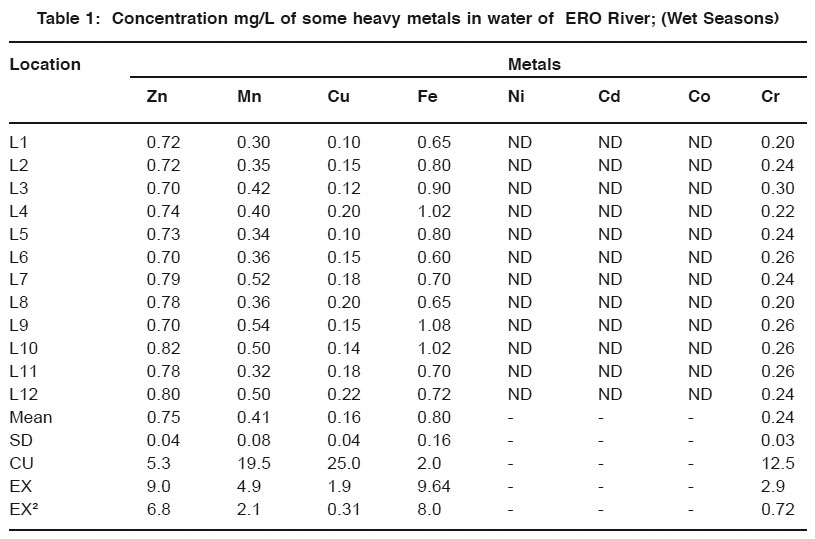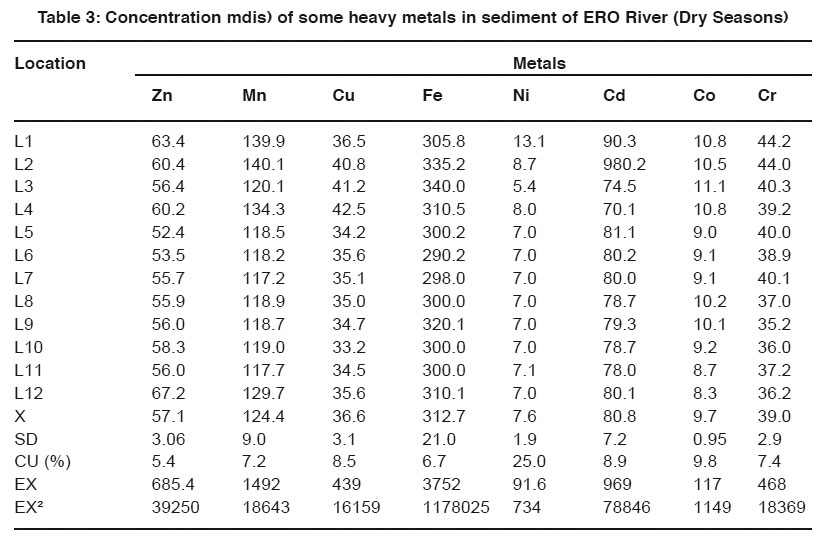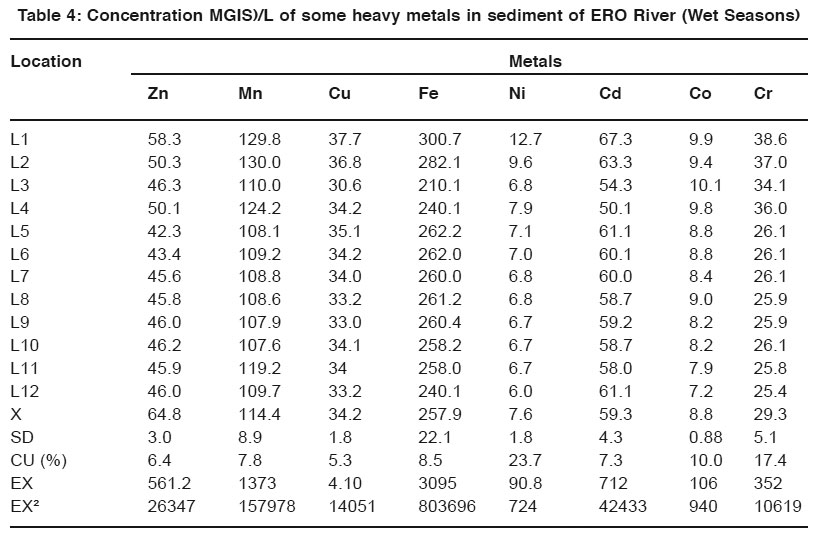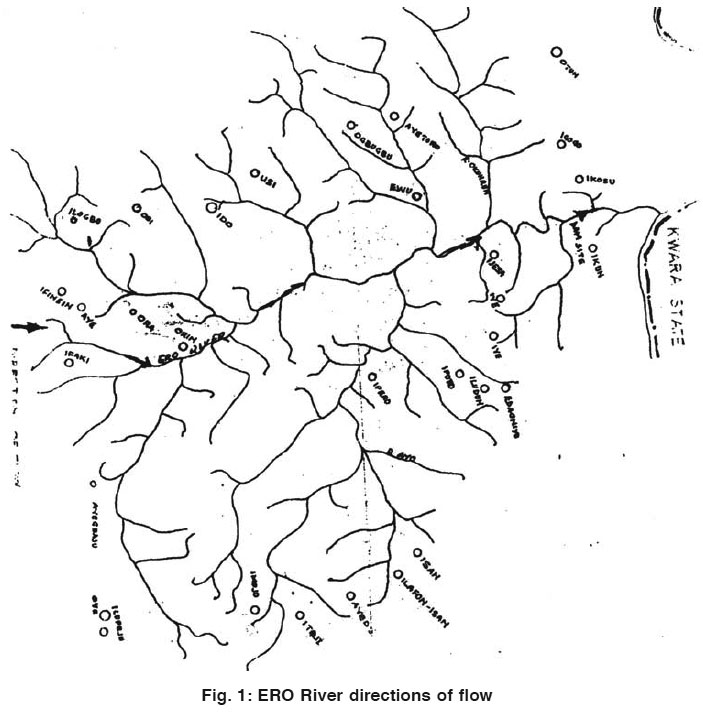Concentration of heavy metals in water and sediment samples from ERO river in Southwestern, Nigeria
S.S. Asaolu1 * , O.S. Adefemi1 and O. Borode1
1
Chemistry Department,
University of Ado-Ekiti,
Ekiti State
Nigeria
DOI: http://dx.doi.org/10.12944/CWE.4.1.05
The distribution of heavy metal concentration in water and sediment samples from Ero River in South western, Nigeria was carried out for a period of dry and wet season. For both seasons Ni, Cd, Co were not detected in the water samples, while all metal examined were detected in the sediment samples. The concentrations of heavy metals were higher in the sediments than water sample. On the average the concentration of most the heavy metals appears higher in the dry season than wet season. The result obtained fell within the maximum allowable limit set by United State Environmental Protection Agency and World Health Organization.
Copy the following to cite this article:
Asaolu S.S, Adefemi O.S, Borode O. Concentration of heavy metals in water and sediment samples from ERO river in Southwestern, Nigeria. Curr World Environ 2009;4(1):33-38 DOI:http://dx.doi.org/10.12944/CWE.4.1.05
Copy the following to cite this URL:
Asaolu S.S, Adefemi O.S, Borode O. Concentration of heavy metals in water and sediment samples from ERO river in Southwestern, Nigeria. Curr World Environ 2009;4(1):33-38. Available from: http://www.cwejournal.org/?p=883
Download article (pdf)
Citation Manager
Publish History
Select type of program for download
| Endnote EndNote format (Mac & Win) | |
| Reference Manager Ris format (Win only) | |
| Procite Ris format (Win only) | |
| Medlars Format | |
| RefWorks Format RefWorks format (Mac & Win) | |
| BibTex Format BibTex format (Mac & Win) |
Article Publishing History
| Received: | 2009-02-04 |
|---|---|
| Accepted: | 2009-03-05 |
Introduction
With the global aspiration for the provision of potable water for the teeming population, management of water resources with respect to storage, presentation, acceptability and distribution should be of utmost important, this is the reason why the integrity of some major rivers that serves as tributaries to our major dams are kept as regards pollutants distribution. The advent of technological advancement and industrial revolution in many parts of the world, has resulted into chemical pollution of some of our water system that has posed serious challenges for human existence-potable of there pollutants are mainly heavy metals.
The introduction of pollutants into the environment including water from dams, rivers, estuaries could either be from natural or artificial sources, the problem of water pollution with heavy metals has become a global issue most especially in developing countries as a result of the phenomenal growth in both population and industrial activities (Ajayi et al, 1980; Asaolu et al., 1997). Some of the artificial sources of metal introduction into the aquatic environment include oil spillage, sewage effluents, auto emission, dredging activities, garbage dumps and industrial activities such as minning, canning e.t.c (Books and Rumsey, 1974: Finery et al., 1990: Ipinmoroti and Oshodi, 1993, Asaolu et al., 1997).
Domestic sewage and urban water runoffs (Under Wood, 1971) have been recognized as source of trace metal pollution of the aquatic ecosystem. Domestic sewage contains household detergents, which are known to contain trace amount of Fe, Mn, Cr, Zn e.t.c. Metals can also enter aquatic environment by the use of plant nutrients like fertilizer and crop protective measures. This occurs on farmland in urban and rural areas (Adefemi et al.,, 2008). Ero river in Ekiti-State runs through farmlands where rock phosphate and phosphates fertilizer which contain high levels of trace metal especially Cadmium (Forstner and wittman, 1979) are been used. The use of herbicides as gross control measure along highways and other areas have given rise to concern as some of these herbicides contain trace metals. The objective of the present study is to assess the level of heavy metals in both the water and sediments of Ero River located in Southwestern part of Nigeria. Ero River is one of the river that flows to Ero dam which is one of the major dams in Ekiti State that provide potable water to the teaming population in some area of the State. The results obtained will reveal the levels of heavy metals in the river and its possible influence in Ero Dam. It will equally provide environmental awareness for both the public and government for necessary attention.
 |
Table 1: Concentration mg/L of some heavy metals in water of ERO River; (Wet Seasons) Click here to view table |
Material and Methods
Samples
Representative water samples were taken below the water surface using one litre acid leached polythene bottles at 12 different locations along Ero River (Fig. 1) for the period of dry and wet seasons. The samples were chemically preserved by the addition of 5ml concentrated HNO3 for a litre of sample. Sediments samples were collected by divers at the points where the water samples were collected for both seasons (dry & wet) and stored in a polythene bag that has been previously washed and leached with 10% HN03.
 |
Table 2: Concentration mg/l of some heavy metals in water of ERO River; (Dry Seasons) Click here to view table |
Samples Treatment
Five Cm³ of concentrated hydrochloric acid was added to 250mL of each of the water samples and evaporated to 25mL. The concentrate was transferred to 100ml volumetric flask and diluted to mark with deionized water (parker; 1972). 5g of each of the sediments samples was digested using Nwajei and Gagophien (2000) method. The resultant solutions from the digest were analyzed for heavy metals using atomic absorption spectroscopy (Buck model 200A). Result obtained were averages of replicate determinations.
 |
Table 3: Concentration mdis) of some heavy metals in sediment of ERO River (Dry Seasons) Click here to view table |
Results and Discussion
Tables 1 & 2 present the concentration (mg/l) of heavy metals in water sample for both wet and dry season for different location in Ero River. In the wet season, the concentration of Zn, Mn, Cu, Fe, Cr ranged between 0.70 – 0.82, 0.30 – 0.54, 0.10 – 0.22, 0.65 – 1.02, and 0.20 – 0.26 mg/l respectively while during the dry season, it ranged between 0.89 – 0.98, 0.30 – 0.42, 0.29 – 0.44, 0.37 – 0.62 and 0.27 – 0.48 mg/L respectively.
 |
Table 4: Concentration MGIS)/L of some heavy metals in sediment of ERO River (Wet Seasons) Click here to view table |
In most cases, the value of metal concentration indicates that Iron, Zinc, manganese are the most abundant metals in the water sample during the period of the present study. Cadmium was only detected in the water samples during the dry season (Nd.-0.6). From the tables it was observed that the concentration of metals varies between the two seasons. Of all the metals examined for both seasons in the water samples, Iron, Zinc and manganese have the highest values, similar observation have been reported for aquatic environment in Nigeria (Asaolu et al., 1997; Kakulu and Osibanjo, 1988, Adefemi et al., 2004, Adefemi et al., 2008). The high concentration of Iron and zinc in water sample could be of advantage because it has been observed that this metal is an essential nutrients that are required in enzymatic biochemical activities in the body (Asaolu et al., 1997, Kakulu and Osibanjo 1988, Adefemi et al., 2004, Oshodi and Ipinmoroti, 1993). Except in Iron, the metal concentration values for dry season are relatively higher than those of the wet season; this might be due to the inflow of water and other particles during the raining season which might have diluted the concentration of the metals. This is similar to the observation of Asaolu et al., (1997) and Adefemi et al., (2007).
 |
Figure 1: ERO River directions of flow Click here to view figure |
Tables 3 and 4 presents the concentration (mg/g) of heavy metals in the sediment samples, all the metals examined were detected in the sediment samples from the river. The concentrations of Zn, Mn, Cu, Fe, Ni, Cd, Co, Cr ranged between 52.4 – 63.4, 117.2 – 140.1, 33.2 – 42.5, 29.2 – 340.0, 5.4 – 13.1, 780 – 98.2, 8.3 – 11.1 and 35.2 – 44.2 mglg respectively during the wet season while for dry season, the concentration of the metals detected ranged from 42.3 – 53.3, 107.6 – 130.0, 33.2 – 37.7, 210.1 – 300.7, 6.0 – 12.7, 50.1 – 67.3, 7.2 – 10.1 and 25.9 – 37.6 mg/g respectively.
For the period of study, the concentrations of metals in dry season were higher than those of the wet season. This is similar to the observation of Awofolu (2005) who studied the determination and seasonal variation of heavy metals in algae and sediments in senders from industrial areas in Lagos State, Nigeria. For all the metals examined, iron was found to be consistently higher throughout the period of study for both seasons (dry & wet). Similar observation have been reported for iron in the Niger-Delta area (Kakulu, 1988), and also Asaolu (1997) for the Coastal area of Ondo State. Egila and Nimyel (2002) while studying the chemical speciation of sediments from some dams in Plateau State also observed high level of iron in all dams sediment. Adefemi et al., (2007) also observed similar trend when studying major dams in Ekiti State, Nigeria. The high iron content (compared with other metals) in the sediment is excepted because it has been reported that iron occurs at high levels in Nigeria soil (Asaolu et al., 1997, Asaolu and Olaofe, 2004, Asaolu et al., 2005, Nwajei and Gogophien 2000, Adefemi et al., 2007, Ali, 1978). Turekian (1977) noted that in rural areas, the mutual content of soils can be assigned to rock weathering, erosion by gullying and waste that release these particulate materials to the stream. There is no doubt that most waste generated due to human activities are discharged on land or in streams in and around rural area would be transported by runoff water into the surrounding rivers and stream during rains. Although comprehensive data on the various sources, characters and the amount of waste entering Ero River is not available, a knowledge of the heavy metal concentration could give vital information regarding their sources, distribution and degree of pollution, since sedimentation is one of the most important fluxes in aquatic systems (Stephen et al., 2001).
The distribution of metals level in water and sediment samples along the course of the river indicates that the metals are more concentrated in sediment samples than those of water sample which indicates that in the aquatic environment the final repository is the sediment. From the results, it was observed that the concentration of the metal fell below the limit set by USEPA and WHO standard for drinking water, but the river should be closely monitored.The low level of coefficient of variation in both the water and sediment samples suggest nearly even distribution of the metals in the aquatic system. This could indicate that the source of metals levels in the system is from a non point source since the river flows through the forest.
References
- Adefemi O.S,Asaolu S.S and O.Olaofe., Concentration of Heavy Metals in Water, Sediment and Fish(Illisha Africana) from Ureje Dam in Ado-Ekiti, Nigeria. Jour. of Biol. and Phys. Sci. (2004) 3: 111-114.
- O.S. Adefemi, S.S. Asaolu and O. Olaofe., Seasonal Variation in heavy metal distribution in the Sediments of Major Dams in Ekiti-State. Pak. Jour. of Nutri. (2007) 6(6): 705-707.
- S.O Adefemi, S.S. Asaolu and O. Olaofe., Determination of Heavy metals in Tilapia mossambicus Fish,Associated water and Sediment fom Ureje Dam in South Western, Nigeria. Research Jour. of Environ. Sci. (2008) 2: 151-155
- Ajayi, O and Adeleye, S.A., Pollution studies on Nigerian Rivers. Preliminary report on the pollution levels of River ONA and OGUNPA. Bull. Chem. Soc. Nig (1977) 2: 71-79.
- Ali,H(1978): Distribution of Micronutrient in Ibadan siols. M.Sc Dissertation, Department of Chemistry, University of Ibadan, Nigeria.
- Asaolu, S.S , Ipinmoroti, K.O, Adeeyinwo and Oloafe. O., Seasonal variation in heavy metal distribution in sediment of Ondo-State Coastal Region. Ghana Journal of Chemistry. (1997) 1(3): 11-16.
- Asaolu,S.S and Olaofe O., Biomaginification of some heavy metals in sediment, fish and crayfish from Ondo-State Coastal Region. Bioscience Research Communication (2004) 16(1): 33-40.
- Asaolu, S.S, Adefemi,S.O and Onipede, A.F., Interdependecy of some macro and micro metals in the soil of Imo-State, Nigeria. Journal of Environmental and Applied Sciences. (2005) 1: 79-83.
- Awofolu, O.O., Determination and seasonal variation of heavy metals in Algae and Sediment in the sewers from Industrial Area in Lagos State, Nigeria. Pak. Jour. of Ind. Res. (2005) 5: 44-50.
- Brooks, R.R and Rumsey, D., Freshwater Res. (1974) 8: 155.
- Egila, J.N and Nimyel, D.N., Determination of trace metal in sediments from some dams in Plateau State, Nigeria. J. Soc. Nigeria. (2002) 7(1): 71-75.
- Finery, M.W , Madden, J.D , Feaglay, S.E and G ronder, R.M., Arch. Environ. Conta. Toxicol. (1990) 19(1): 94-100.
- Forstner, U and Wittman, G.T.W., Metal pollution in the Aquatic Environment, Berlin, Springer-Verlag. (1979) 486.
- Ipinmoroti, K.O and Oshodi, A.A., Determination of trace metals in Fish, Associated water and soil sediment from fish pond. Discovery and Innovatons (1993) 5(2): 135-138.
- Kakulu, S.E., Heavy metals in the Niger Delta: Impact of petroleum industry on the baselevels; Ph.D Thesis, University of Ibadan, Nigeria (1985).
- Kakulu, S.E and Osibanjo, O., Trace heavy metal pollutional status in the sediment of Niger Delta area. Nig. Jour. Chem. Soc. (1988) 13: 9-15.
- Nwajei, G.E and Gagophien, P.O(2000): Distribution of heavy metals in the sediment of Lagos Lagoon. Pak. Jour. Sci. Res. 43: 338-340.
- Parker, R.C., Water analysis by Atomic Absorption Spectroscopy. Varian Tectron. Switzerland (1972).
- Turekian, K.K., The fate of metals in Ocean, Geochemica at Cosmochemicl Accta G.Britian (1977) 41: 1139-1140.
- Underwood, E.J., Trace element in human and animal nutrition. 3rd Edition. London Academic Press (1971).






